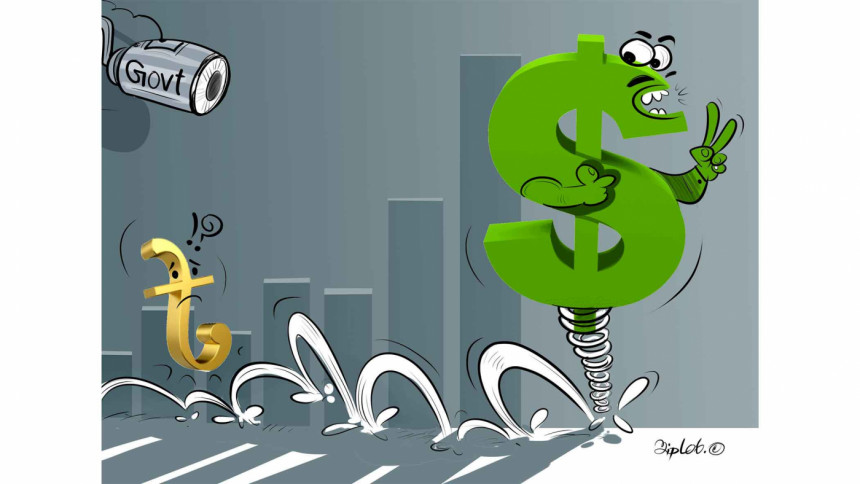Originally posted in The Daily Star on 23 May 2022
 Exchange rate management is an important task for the central bank. In Bangladesh, though the central bank follows a floating exchange rate, it manages the foreign exchange market through intervention. Even then, the volatility in the forex market has reached a record level. The supply of dollars to the economy is less than the demand. There have also been panic purchases.
Exchange rate management is an important task for the central bank. In Bangladesh, though the central bank follows a floating exchange rate, it manages the foreign exchange market through intervention. Even then, the volatility in the forex market has reached a record level. The supply of dollars to the economy is less than the demand. There have also been panic purchases.
The global economy is experiencing weak growth, high inflation, and supply disruptions in the aftermath of the Covid pandemic as well as in the wake of the Russia-Ukraine war. The inflationary pressure is felt in Bangladesh, too, primarily due to high import costs. During the first nine months (July-March) of the 2021-22 fiscal year, import payment increased by 44 percent, while export income increased by 33 percent. This implies that the trade deficit has gone up to USD 24.9 billion. On the other hand, remittance has fallen by 18 percent during the same period. As a result, the current account deficit has increased to about USD 14 billion during the above-mentioned period.

The demand for foreign currency has also increased on account of travelling as borders have reopened. More students have started to go abroad for higher studies, which had declined due to the pandemic. Even though their tuition fees are paid through formal channels, the out-of-pocket expenditures are managed through purchases from the kerb market beyond official travel quotas. For medical treatment, people buy the US dollar through informal channels as expenses cannot be met through credit cards because of transaction limits. Due to procedural delays, many do not want to go through the formal channel of applying to Bangladesh Bank. In addition, foreign currency demand is high during Hajj. There is also pressure on foreign currency because a large part of ill-gotten money is transacted via foreign currency these days.
The pressure on foreign exchange has not only led to the devaluation of the taka against the dollar, but also to at least three exchange rates, making the situation complex. In the informal market, USD 1 is traded at around Tk 100. On the other hand, the interbank rate has been Tk 94-96 per dollar, while banks are selling USD 1 at Tk 96-98. But the Bangladesh Bank sells USD 1 at Tk 87.50. In order to avoid the pressure to transact at the dictated spot rate, banks were seen transacting in the short-tenured forward rate. As a result, business is being performed at a higher cost.
During FY2021-22, the Bangladesh Bank injected about USD 5 billion into the forex market to keep the exchange rate stable. This may have helped the government to import fuel and other essential commodities at lower prices, but this could not stabilise the exchange rate. Indeed, the taka has been devalued against the dollar by only 3.38 percent during the first nine months of FY22. Several countries including China, India, Pakistan, Sri Lanka, the Philippines, Turkey, and the UK have devalued their local currencies by 5-50 percent.
As a trading nation, Bangladesh tries to maintain an exchange rate that helps both exporters and importers. The current crisis requires immediate government intervention to improve foreign currency supply into the market. Here are eight concrete recommendations to overcome the current forex challenges.
1) A separate fund should be set up for government imports such as fuel. This should be given to banks only for settling government imports; banks will not keep any profit margin for these payments. This will reduce pressure on the private sector demand for the dollar for the import of other essentials.
2) The Export Retention Quota (ERQ) should be reduced to 5-10 percent of repatriated proceeds for the exporters for the next six months. They need to encash everything other than back-to-back import payments for the next six months.
3) The current Net Open Position (NOP) of banks should be reduced by 50 percent immediately to inject forex flow into the market. Seventy-five percent of the existing NOP should be immediately sold off to the interbank market to facilitate supply to different banks.
4) The Bangladesh Bank should inject another USD 1-2 billion from the reserves to stabilise the market and reduce panic-buying in order to bring down the exchange rate. It may be mentioned that to support the rupee against the dollar, the Reserve Bank of India sold USD 20.1 billion in the spot forex market in March 2022.
5) The taka should be devalued to be closer to the interbank rate and be realistic to the market rate to align with the current situation. This should cool the market down and restore stability.
6) The forex reserves should be used judiciously. Import of luxury items should be restricted till the situation improves.
7) Effective measures involving all stakeholders are needed to improve the remittance flow. Remittances are not coming through the banking channel even after the incentives given to the remitters. Hundi is more lucrative to remitters as it offers higher rates compared to the formal banking channel.
8) Bangladesh should gradually establish links with the future commodities market to ensure a long-term supply contract with a few global suppliers. Of course, Bangladesh must increase its trading capacity to operate in the international commodities market.
The current exchange rate volatility is neither useful for business, nor individuals. The forex market is the major determinant of inflation. Therefore, a stable exchange rate is important for price stability. This, in turn, will help maintain a stable macroeconomy. The government should be proactive as well, because the inflationary pressure has hit the poor and low-income groups hard in the current circumstances.
Dr Fahmida Khatun is executive director at the Centre for Policy Dialogue (CPD). Views expressed in this article are the author’s own.



